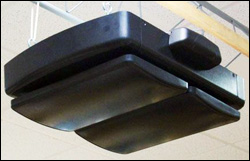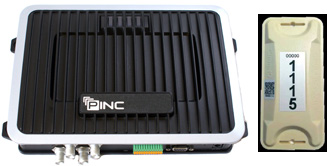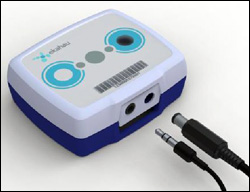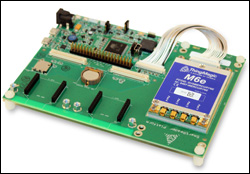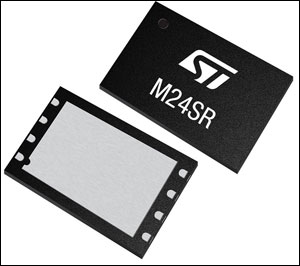The following are news announcements made during the past week by the following organizations: Checkpoint Systems; PINC Solutions; Ekahau; ThingMagic; STMicroelectronics; TagMaster and Bombardier.
Checkpoint Systems Enhances RFID-Based Overhead EAS Solution
Checkpoint Systems has announced Overhead 2.0, a new version of its RFID-based electronic article surveillance (EAS) system, which the company says offers improved inventory visibility and loss-prevention benefits at the point of exit. Overhead 2.0 leverages what Checkpoint calls the OneTag approach—the use of EPC Gen 2 (ISO18000-6C) RFID tags for both inventory visibility and loss prevention—which, according to the company, simplifies deployment and reduces tag costs. Source tagging can be accomplished using RFID-only tags, or with Checkpoint’s dual tags, which combine an RFID inlay with an EAS tag (either acousto-magnetic or RF). By dual-tagging their merchandise at the source, apparel retailers are prepared for loss prevention, both at RFID-equipped stores and at traditional EAS-equipped stores, according to Checkpoint. Retailers with RFID source tagging in place can expand to a full Checkpoint Merchandise Visibility implementation, covering receiving, front store/back store transitions, cycle counting and inventory counts, and point of sale. Optimized for use by specialty apparel and fashion retailers using RFID for inventory management, Overhead 2.0 is engineered as a standalone exit-door solution at new and remodeled stores, or with traditional EAS systems at existing stores, as part of a retailer’s RFID adoption strategy. The solution leverages Checkpoint’s Wirama Radar technology, a combination of patented RFID reader hardware and software. The upgraded Overhead 2.0 console unit, which contains an RFID reader and antenna, covers much higher ceilings and wider retail store entrances than the original Overhead solution. Specifically, it covers entrances up to 20 feet wide and 12 feet high, representing more than a 50 percent improvement in exit door width and a 20 percent increase in height over the original design. The console, which measures 22 inches long, 17 inches wide and 4.6 inches in height (559 millimeters by 432 millimeters by 117 millimeters), is significantly smaller than the previous design, which Checkpoint says allows the unit to be installed in tight spaces for maximum deployment flexibility. Overhead 2.0 also features an advanced electronics design that, according to the company, improves its tag-reading accuracy and performance. Overhead 2.0 is commercially available now in North America, and is slated to be offered in Europe next month, and in the Asia-Pacific region in January 2014.
PINC Updates RFID Hardware for Yard-Management Solution
PINC Solutions has updated a gate-mounted RFID reader as part of its ultrahigh-frequency (UHF) RFID-enabled yard-management system. According to PINC, the physical configuration of its gate-mounted RFID reader, which features Motorola Solutions‘ FX9500 industrial fixed reader, has been simplified by removing the outer steel case. This new configuration, PINC reports, improves cooling and placement options, and is easier to service. The company has also announced that its RFID tags—designed to be mounted onto trailers—are now in full production. Made with a Omni-ID Dura 1500 on-metal passive EPC Gen 2 tag, it is encased in ABS plastic designed to resist heat and cold, and earning it an IP 68 rating, signifying it as dustproof and waterproof. Each PINC tag is encoded with a unique 24-digit PINC ID, assigned and locked at the point of manufacture, and the company adds a unique, human-readable, nine-character hex serial number label to the tag, a 13-character hexadecimal bar-code label and a QR label encoded with a URL. To register the PINC RFID tag, a user scans the tag’s QR or bar-code label via any smartphone or tablet. Depending on the fixed RFID reader used, the tag has a read range of up to 50 feet—or, in the case of handheld device, up to 24.5 feet (in North America, Canada and Mexico). The PINC RFID tag is available with permanent mounting capability, using the recommended hardware and drill settings. For situations in which a tag needs to be temporarily attached to a trailer, PINC has also developed a new magnetic removable mounting bracket; the Omni-ID Dura 1500 tag is placed inside the bracket, which uses two powerful magnets to securely attach it to a trailer. According to PINC, the bracket has built-in handles making it easy to remove.
Ekahau Intros A4+ Asset Tag and W4 Wristband Tag
Ekahau has announced two new active RFID products for its RFID-over-Wi-Fi real-time location system (RTLS): the externally powered A4+ asset tag and a more rugged W4 patient wristband tag. The new A4+ tag, similar to the A4 tag released in 2011 (see RFID News Roundup: Ekahau Adds Combination IR and Wi-Fi Asset Tag to RTLS Portfolio), features the same industrial design, but can be powered via external battery packs or power sources such as 5V USB chargers, which Ekahau says gives it unlimited operational time. A built-in backup battery enables the A4+ tag to operate when its external battery pack is low or power is cut. The new W4 wristband tag—replacing Ekahau’s T301W tag, which will be discontinued—features a watch-like design that sits flat on a wearer’s wrist, as well as a tactile help button and detachable wristbands that simplify tag re-charging and cleaning, the company reports. New features (not available in the T301W model) include an IP 67 rating that signifies it as dustproof and waterproof (the T301W was only splash-proof), a bar code for simplified ID scanning and a charger that can recharge 10 tags simultaneously with wristbands still attached, thereby saving time (with the T301W, wristbands had to be removed for recharging).
ThingMagic Launches Mercury xPress Development Platform to Simplify Integration of Embedded RFID Readers
Trimble‘s ThingMagic division has announced the Mercury xPress Platform, a development platform designed to simplify the process of bringing application-specific EPC Gen 2 ultrahigh-frequency (UHF) RFID readers and embedded solutions to market. Mercury xPress provides embedded RFID technology with an integrated software-development environment, as well as transport interfaces and communication plug-ins, all on a single platform. The platform includes reference design files, including schematics, layout files, Gerber files and bill-of-material and component data sheets (all of which are downloadable), and is designed to help reduce the need for developers to have significant RFID domain expertise. The xPress platform is not a replacement for Trimble’s standard Mercury DevKit, the company notes. Instead, it is designed to operate as an extension of the Mercury DevKit, with additional tools and resources designed to ease the development process and help reduce the amount of time it would otherwise take a developer to bring a concept to market, the firm adds. The Mercury xPress is built on ThingMagic’s Mercury C application programming interface (API), and enables developers to design and test reader and tag commands, advanced read functionality—such as setting antennas, protocols and filtering criteria—advance tag operations (kill and lock tags), privacy and security features, and performance and memory optimization. The platform includes sample applications for common use cases, and, according to Trimble, developers can bring up a fully functional RFID reader within minutes. Testing and proof-of-concept activities (using the sample applications) can start almost immediately. Key components of the Mercury xPress include a hardware kit (comprising a microcontroller-based motherboard; integrated ThingMagic Micro, Micro-LTE or M6e RFID modules; a USB interface; and ports for up to two additional plug-in data transport interface modules), a microcontroller preloaded with a sample keyboard wedge application, an optional Bluetooth plug-in module, and a downloadable software toolkit and software developers kit (SDK). The Mercury xPress Platform has been screened for regulatory compliance, the company reports, and is expected to be made available next month.
STMicroelectronics Unveils Family of ICs for Embedding NFC Tags in Electronic Devices
STMicroelectronics has introduced a new family of embeddable RFID chips designed to make it easier to add Near Field Communication (NFC) capability to any type of electrical device, from loudspeakers and printers to cookers, washing machines, and electricity, gas and water meters. The M24SR family of NFC RFID chips contain three key elements: non-volatile memory (NVM) that retains its stored data even when its power supply is switched off; a wireless RFID interface for communicating with other wireless devices; and a wired interface (industry-standard I2C) for communicating with the host equipment’s controller. In the M24SR family, the NVM is implemented as Electrically Erasable Programmable Read-Only Memory (EEPROM), ranging 2, 4, 16 or 64 kilobits in size. The wireless interface is compatible with the ISO 14443A protocol, enabling data rates of up to 106 kilobits per second. The I2C interface operates at frequencies of up to 1 MHz, for data transfer between the smartphone and the target equipment. According to STMicroelectronics, the EEPROM memory bank is preformatted for NFC operation, supporting the NFC Data Exchange Format (NDEF), and uses the latest EEPROM technology, with data retention guaranteed for 200 years, one million write-erase cycles, and 128-bit password protection for maximum security. “The key benefit of embedding NFC capability into almost any kind of equipment or device is that the device can then be designed to offer all the features that would be possible if they had keyboards, graphic displays and Internet connections, without actually having to incorporate these expensive and space-consuming features into the equipment itself; the user’s smartphone already has them and can ‘lend’ them,” said Benoit Rodrigues, the general manager of STMicroelectronics Memories Division, in a prepared statement. “The M24SR family enables a new paradigm in how to interact with the world around us. Today, smartphones are increasingly at the center of how we interact with other people. Tomorrow, they will also be at the center of how we interact with everything we own or use.” An example of how the M24SR family could be used in a real-world application is the enabling of Bluetooth pairing between a smartphone and an audio device. Instead of having to open the phone’s settings, activate the Bluetooth connection, select the audio device code name and sometimes enter a pass code, a user can simply wave his or her smartphone by the NFC-enabled audio device, and thereby automatically activate Bluetooth pairing between the two devices as settings have been transmitted over NFC, STMicroelectronics explains. Other examples include resetting the clock on any appliance following a power blackout or a change in daylight saving hours, or rapid diagnosis of faults in malfunctioning equipment. Instead of having to look for the instruction manual or call the manufacturer’s customer service, the user could simply run the “Reset my appliance clock” or “Diagnose problem” app on his or her smartphone, the company reports, and touch the equipment with the smartphone, and the clock would be automatically reset, or the problem remotely diagnosed, via the connection to the manufacturer’s website. Offered in compact SO8, TSSOP8 and MLP8 packages, the M24SR devices are now available in samples for original equipment manufacturer (OEM) customers.
Bombardier Transportation Picks TagMaster’s RFID Solution for Mass-Transit Project in Malaysia
TagMaster, a producer of advanced RFID solutions for rail applications, has announced that it has received a new order from Bombardier‘s transportation business to provide TagMaster’s advanced RFID solution—which will include heavy-duty 2.45 GHz interrogators and, eventually, active RFID tags—for a project in Malaysia. Bombardier has placed an initial order with TagMaster valued at 3.5 million Swedish crowns ($526,000) for the heavy-duty interrogators, which will be delivered between 2013 and 2014. Additional orders for TagMaster’s HD ID-Tags, as well as spare parts for the project, are anticipated during 2014, according to the RFID vendor. The TagMaster equipment will be deployed as part of Bombardier’s mass-transit train-control solution, which is being delivered to the new Klang Valley Mass Rapid Transit (KVMRT) Sungai Buloh to Kajang (SBK) line, which is being constructed in Kuala Lumpur. Once the line is completed, the 51-kilometer (31.7-mile) SBK line will significantly increase passenger connections in the Greater Kuala Lumpur area, TagMaster reports, and serve approximately 1.2 million people. Bombardier’s scope comprises the design, supply, installation and commissioning of Bombardier’s Cityflo 650 communications-based train control (CBTC) solution for automatic driverless operation. The line includes 31 stations and onboard equipment for 58 trains and 16 maintenance vehicles. “TagMaster continues to be our strategic supplier of RFID-based automatic train identification and positioning technology to Bombardier,” said Jeff Stover, the director of signaling engineering at the Pittsburgh site of Bombardier Transportation’s Rail Control Solutions division, in a prepared statement. “We are pleased to again confirm TagMaster as our chosen solution for another significant Cityflo 650 project in Asia.”

